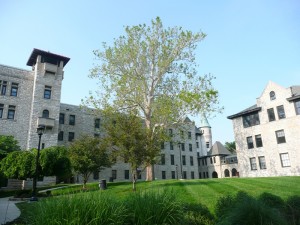Considering I live in the 3rd largest U.S. Metropolitan Statistical Area and work at a very urban-focused museum, I sure spend a lot of time thinking about barns.
This is partially because of where I grew up, and partially because of my work in grad school. And it’s partially because of where I live – surrounded by hard surfaces and right angles, and grey, and glass, and smog. I don’t see a lot of rural agriculture in my day to day and maybe that’s why my mind goes to barns when I need a little escape.
My thoughts can be summarized like this: What should we do with them?
I wish I had a good answer. Hell, I wish I had a consistent answer.
Yesterday, I was talking to Mom about barn salvage companies that dismantle deteriorating or collapsed barns and relocate, rebuild, or resell them. For a long time, I’ve had an aversion to these operations because of the way they divorce the building from its site. Sure, technically materials are preserved in that they don’t burn or rot away but I shy away from calling it capital-P Preservation. It’s conservation without context. It creates spectacle without teaching anything. It serves an individual good, not a greater good.
But Carla Bruni brings up an excellent point on her awesome blog that by design barns (and other agricultural buildings) were designed to be used and reused, torn down, reassembled, lather, rinse, repeat. Indeed, if you’ve ever seen a rambling barn way out in the middle of a field and wondered what it’s doing there, the answer is that it probably was cobbled together out there – put together out of one or more disassembled buildings that had been moved for the purpose of having a temporary place to stash hay. Or maybe a local crop. Or something.
Point is, barns were made to be modular and reusable, so why should I get in the way of that? Carla points to John Ruskin, who – when I’m talking preservation to students here at the museum – I like to put on a Preservation Spectrum (I call dibs on that phrase) with Eugene Viollet le Duc. Ruskin thought that the best and most truthful a building could be was one that was never monkeyed around with. (His words. Ok, fine. My words.) You built it, let it live and decay over time, and it would only get more truthful and beautiful with age. Bob McCullough, one of the finest teachers I’ve ever had, would ask “Why don’t we have ruins in this country?” That’s Ruskin right there. Viollet le Duc was about 180 degrees away from that approach. He thought that historic preservation should be embodied in restoration, which was the “means to reestablish [a building] to a finished state, which may in fact never have actually existed at any given time.” To le Duc, restoration was a way to improve upon history to create the idealized whole of what an historic building should have been.
The thing that’s great (and harrrd) about preservation is that it’s different for every project and that it usually falls somewhere in the middle of that spectrum. The preservation of our built agricultural heritage is no different. There’s no overarching RIGHT ANSWER. There’s just a thought process and a continuing conversation about how we can best be served by the historic building stock and how it can best be served by us.
As a grad student, I was privileged to work with the early stages of the Vermont Barn Census – a project to record information on the state’s five to fifty thousand historic barns. During my time there, I helped to develop the process for volunteers to follow, wrote a visual glossary for them to take into the field to help identify building types, and found time to give an interview or two. The goal of the census isn’t to tell property owners what they should do, but to foster a conversation within the state and around the country about what’s out there, what best conservation practices should be, and how barns and such can be used going forward.
It’s worth thinking about, especially when you learn how much rural, and specifically agricultural, landscape we lose every year. Staggering amounts. History, as they say, is written on the land. Buildings, in this case buildings related to our agricultural heritage, are a big part of reading that history. What are we going to do when they’re gone? What’s going to tell the story then?
Remember, culture and heritage are sustainable resources. Barns present unique challenges and opportunities, but what’s important is that we open our eyes, see what’s out there, and start a conversation




